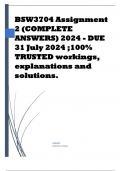BSW3704 Assignment
2 (COMPLETE
ANSWERS) 2024 - DUE
31 July 2024 ;100%
TRUSTED workings,
explanations and
solutions.
ADMIN
[COMPANY NAME]
,Question 1: Protecting Child's Rights (15 marks) Explain how a
social worker can protect the child’s rights, emphasizing
participation, the best interest of the child, and dignity throughout
child protection services. Provide practical examples of
interventions that uphold these rights.
Protecting a child's rights is paramount in social work, and it
involves ensuring their participation, considering their best interests,
and upholding their dignity throughout all interventions. Here’s how
a social worker can achieve this:
Participation of the Child
Participation means involving the child in decisions that affect them,
considering their evolving capacities and perspectives:
1. Active Listening and Respect: A social worker should
actively listen to the child, respect their views, and involve
them in discussions about their safety and well-being. For
example, during a case conference or assessment, the social
worker should ask the child directly about their preferences
and feelings regarding their living situation.
2. Information Sharing: Ensure that information is
communicated in a way that the child understands, avoiding
jargon and using age-appropriate language. This empowers the
child to participate meaningfully. For instance, explaining the
legal process or reasons behind decisions in simple terms.
3. Support for Decision-Making: Provide support for the child
to express their opinions and wishes, even if these differ from
adults' views. This could involve advocating for the child’s
preferences in court proceedings or family meetings.
,Best Interest of the Child
The best interest principle guides decisions to prioritize what is best
for the child's overall well-being:
1. Comprehensive Assessment: Conduct thorough assessments
that consider the child's physical, emotional, psychological,
and developmental needs. This might involve consulting with
teachers, caregivers, and healthcare professionals to gather a
holistic view.
2. Holistic Planning: Develop intervention plans that cater to the
child’s specific needs and strengths. For example, arranging
for educational support, therapy sessions, or recreational
activities that promote healthy development.
3. Advocacy for Resources: Advocate for resources and services
that are in the child’s best interest, such as access to healthcare,
educational support, or specialized therapies.
Upholding Dignity
Respecting the child’s dignity involves treating them with
sensitivity, recognizing their individuality, and protecting their
privacy:
1. Confidentiality: Ensure confidentiality of sensitive
information shared by the child, only disclosing when
necessary for their protection or well-being.
2. Respectful Interactions: Interact with the child in a manner
that respects their dignity and autonomy. For instance,
allowing the child to express their emotions without judgment
and acknowledging their experiences.
3. Cultural Sensitivity: Consider cultural factors in interactions
and decision-making processes. This includes respecting
, cultural practices and beliefs that are significant to the child
and their family.
Practical Examples of Interventions
• Case Management: Regularly involving the child in case
reviews and decision-making processes, such as where they
will reside or with whom they will have contact.
• Therapeutic Support: Arranging for counseling or therapy
sessions to help the child cope with trauma or express their
feelings in a safe environment.
• Education Advocacy: Ensuring the child has access to
appropriate educational opportunities and advocating for
accommodations if needed due to emotional or developmental
challenges.
• Legal Support: Supporting the child during legal proceedings
by explaining processes, advocating for legal representation,
and ensuring their voice is heard in court decisions.
In conclusion, protecting a child’s rights as a social worker involves
actively promoting their participation, prioritizing their best
interests, and upholding their dignity in all interactions and
interventions. This ensures that interventions are not only effective
but also respectful of the child’s autonomy and well-being.
Question 2: Continuum of Care (15 marks) Identify and describe
interventions relevant to each level of care on the continuum of
services associated with child protection services: prevention; early
intervention; statutory services; family reunification; aftercare.




